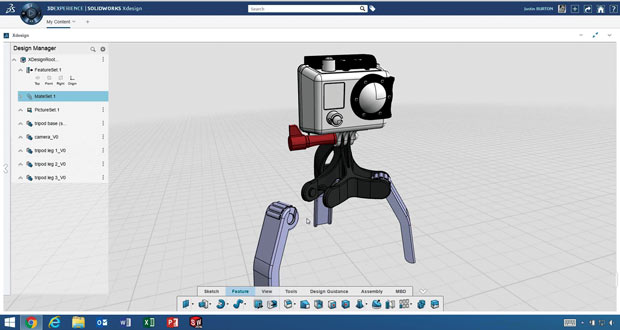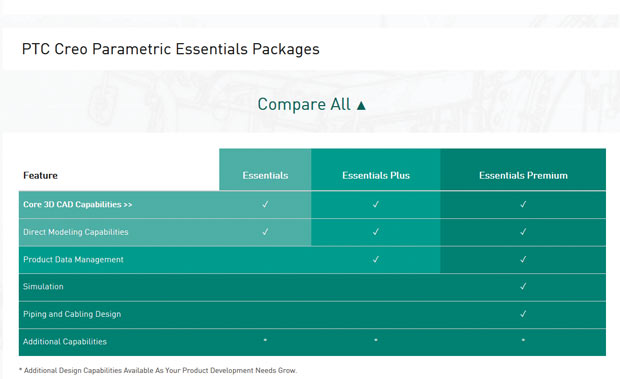
SOLIDWORKS Xdesign, a new product from the creators of the SOLIDWORKS CAD program, runs inside a browser and is mobile-friendly. Image courtesy of SOLIDWORKS.
Latest News
April 1, 2016
 SOLIDWORKS Xdesign, a new product from the creators of the SOLIDWORKS CAD program, runs inside a browser and is mobile-friendly. Image courtesy of SOLIDWORKS.
SOLIDWORKS Xdesign, a new product from the creators of the SOLIDWORKS CAD program, runs inside a browser and is mobile-friendly. Image courtesy of SOLIDWORKS.The general practice in the design and engineering software industry is to bundle everything you might possibly need into a single package. A standard 3D CAD program usually comes with 2D drafting, 3D mechanical modeling, sheet metal, photorealistic rendering and basic stress analysis. In some, you might even find rudimentary free-form modeling, surface modeling, collaboration functions and workgroup-level document management tools. If you routinely make use of all these features in your workflow, you’re probably what people call a “power user” and you’re certainly getting your money’s worth. But if you’re like most CAD users, you may use only about 35%-45% of the commands regularly, you occasionally delve into the remaining features, and you’ve only launched some of the most advanced features once or twice.
With the shift to subscription software (see “The Growing Demand for On-Demand Licensing”) some CAD vendors are going back to refashion their all-encompassing products as a series of smaller modules instead. Others are introducing smaller, lighter design programs aimed at hobbyists and makers. Either way, it has serious implications on software cost and adoption.
Small Fish Can Fill an Ocean
“In the last few years, our strategic focus has been shifting from the top of the pyramid to the global customers in the lower tiers,” says Brent Edmonds, PTC’s senior director of CAD Segment. “That’s where we see the CAD business growing — specifically PTC Creo.”
In the Pro/ENGINEER era, PTC was closely associated with large automotive and aerospace manufacturers — but not so much in the Creo era. Edmonds revealed that, last year, roughly 50% of PTC’s revenues came from the small- and mid-sized customers, making this segment impossible to ignore. “In our Creo and Mathcad businesses, there are accounts with just a single seat or two. We’re developing a program to address startups and small design shops with one to three employees,” says Edmonds. “It’s to help them get off the ground without a substantial investment.”PTC isn’t ready to reveal details about its startup program yet, but Edmonds says: “True startups may even be able to get access to our software at no cost until they start to get business and become established.”
X Marks the Spot
Check any manufacturing job posting and you’ll most likely come across SOLIDWORKS listed as a skill requirement. The widely adopted mechanical CAD package, part of Dassault Systèmes’ portfolio, was previously only available as a perpetual license, but early this year, at the SOLIDWORKS World user conference, the company announced plans to make SOLIDWORKS available for short-term rental under quarterly and annual licenses.
Furthermore, the company introduced a series of X-branded products: Xdesign for modeling and Xdrive for cloud-hosted storage, for a start. “Xdesign is a new, browser based, full SaaS, product design offering based on Dassault Systèmes’ 3DEXPERIENCE Platform. Not everybody wants, or can do product design in the same way. Xdesign addresses the needs of those users who choose to work online and in a browser,” says Milos Zupanski, director of Product Portfolio Management at SOLIDWORKS.
The new product Xdesign includes what SOLIDWORKS CEO Gian Paolo Bassi described at the conference as “a baby version of topology optimization.” Zupanski explains: “Instead of starting with an empty space, Xdesign suggests what products should look like.”
The company hasn’t revealed Xdesign’s price. The product could be an easier, lighter alternative for hobbyists and makers who don’t need everything in a full-featured parametric CAD program and find its learning curve too steep.
Multi-Tiered CAD
Six years ago in 2010, PTC’s all-in-one CAD package Pro/ENGINEER underwent a drastic transformation. The company broke up a single product into PTC Creo-branded modules. What used to be families of features inside Pro/ENGINEER became their own discrete products, such as PTC Creo Parametric, PTC Creo Direct, PTC Creo MCAD View, PTC Creo ECAD View, PTC Creo Schematics, PTC Creo Sketch, and more. Back then PTC — like many others in the CAD segment — was skeptical of subscription CAD; nevertheless the modular approach turned out to be a prelude to its wholehearted embrace of the subscription model later on. (Editor’s Note: For more on PTC’s subscription licensing, read “PTC Subscription: Acceptance of the New Way Customers Want to Buy Software.”)
Late last year, PTC announced it was putting its entire product portfolio on subscription. With this sweeping move, the company debuted three different levels: Essential, Essential Plus and Essential Premium. All three include the core 3D modeling and direct editing functions. But other advanced features like product data management, simulation, and piping and cable design are pegged to the two higher levels: Essential Plus and Essential Premium.
PTC doesn’t publish its subscription prices, but according to Edmonds, it is “a fraction of the price of a perpetual license, and it’s in line with the software industry’s subscription pricing.” He adds: “Our customers’ transition to subscription is going even faster than we’ve planned for.”
 PTC’s new Creo Essentials subscription chart shown here reflects how CAD software is broken into different levels for easier consumption under the subscription model. Image courtesy of PTC.
PTC’s new Creo Essentials subscription chart shown here reflects how CAD software is broken into different levels for easier consumption under the subscription model. Image courtesy of PTC.PTC’s multi-tiered system is similar to Siemens PLM Software’s offer of Solid Edge under subscription, introduced much earlier in 2013. Under Solid Edge subscriptions, those who need only basic 2D and 3D may choose Design and Drafting ($100 per month); those who work with surfaces, sheet metal, weldments and frames may choose Foundation ($230 per month); those who need rendering and part-level structural analysis may subscribe to Classic ($290 per month); and those who want assembly-level analysis, electric cable design, piping and tubing design as well as other advanced features may subscribe to Premium ($420 per month).
With a head start in subscription, Autodesk, too, offers its primary mechanical CAD product Inventor with different clusters of features. Inventor LT ($50 per month) gives you the most basic 3D modeling. Inventor LT Suite ($55 per month) gives you AutoCAD LT and Inventor LT. Standard Inventor ($235 per month) gives you core 3D modeling. Inventor Professional ($385) gives you simulation in addition to 3D modeling. As you move up the ladder to Product Design Suite ($290 per month), you also get electrical design, simulation, tooling and project management.
Onshape, founded by a team of former SOLIDWORKS executives, offers its browser-based CAD software for free to those who keep their number of private project files and data storage below the maximum allotted. Most professional users, however, will likely subscribe to Professional Edition ($100 per month) with unlimited storage. The company also offers Enterprise Edition (price unpublished), which comes with administrative tools and analytics.
“It’s a lot cheaper to make people aware of Onshape that way [with the free offer]. Otherwise, I’d have to send an application engineer to go to a prospective customer’s site to give a tutorial, then have them sign a document that says they can only use the software for a set amount of time,” said Dave Corcoran, Onshape’s VP of R&D. “We forego those costs. The free version is our marketing engine; the fee from the paid version supports the free version.”
Onshape itself doesn’t offer simulation or rendering functions, but its partners do. These partners also offer free versions of their plug-ins. (For more on Onshape, read our coverage of the democratization of high-performance computing in “Preparing for the HPC Floodgates to Open.”)
The subscription option to scale up to get access to the more advanced functions like simulation and electrical design, and the option to scale down when the project no longer demands them, may entice new users who have previously stayed away. Siemens PLM Software and Autodesk offer subscriptions as short as a single month, along with quarterly and annual options. PTC’s subscription currently requires at least a one-year commitment, but Edmonds suggested more short-term options are coming in the future.
AutoCAD Rivals in 2D
In the last decade, a series of primarily 2D CAD products emerged to challenge Autodesk AutoCAD’s dominance. They include IMSI/Design’s DoubleCAD XT (free), Dassault Systèmes’ DraftSight (free), and Siemens PLM Software’s Solid Edge 2D Drafting (free).
For those who feel comfortable working with CAD files on mobile devices, the free and low-cost options are even greater. Autodesk also offers AutoCAD 360 (formerly AutoCAD WS) as a free mobile app for creating, viewing, and editing 2D DWG files.
The Changing Definition of Low-Cost CAD
Previously, many serious engineers scoffed at the notion of low-cost CAD, generally considered amateurish modeling programs with little or no support. Free consumer-friendly modelers like TinkerCAD, on the other hand, have only the most basic building blocks to create simple shapes, making them attractive to educators but less than ideal to product designers. The software you get with subscription, however, is a different breed. They’re the industry-standard professional 3D modeling programs, but broken up and repackaged to make it them more accessible and consumable.
With some starter editions, you get fewer features, but that’s welcome news for those who don’t need anything beside the basics. You might argue subscription pricing is not truly “low cost” because over time the subscriber pays more for the software. However, for startups with cash flow challenges, the option to pay smaller subscription fees incrementally may be a better alternative to the initial investment required to purchase the software outright.
Pressure from rivals may also drive the price down further. China-based ZWSoft’s ZWCAD Classic is listed at online CAD software vendor Novedge’s catalog for $569. Pricing for Germany-headquartered Graebert’s ARES CAD package begins at $250 for annual licenses or $795 perpetual licenses.
In 2010, Texas-based Alibre dropped the price of its parametric CAD package Alibre to $97. At a time when comparable 3D modeling programs were sold for $2,000 to $5,000, Alibre’s sub-$100 price thumbed its nose at the industry norm. Alibre has since been acquired by 3D Systems and the software was morphed into Geomagic Design. At online design software retailer Novedge, Geomagic Design with one year of maintenance is currently listed at $2,279.
Nevertheless, a quick glance at the current CAD subscription prices will tell you that instant access to a robust 3D mechanical modeling program for less than $100 per month is not out of ordinary. It is, in fact, the new normal.
More Info
Subscribe to our FREE magazine, FREE email newsletters or both!
Latest News
About the Author
Kenneth Wong is Digital Engineering’s resident blogger and senior editor. Email him at [email protected] or share your thoughts on this article at digitaleng.news/facebook.
Follow DE





